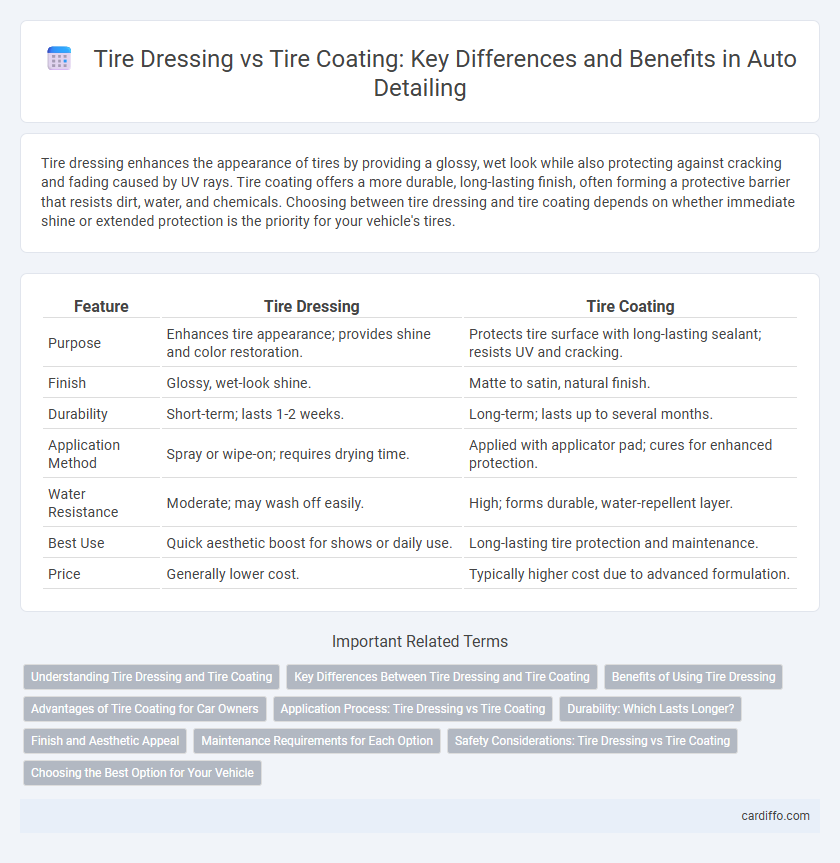Tire dressing enhances the appearance of tires by providing a glossy, wet look while also protecting against cracking and fading caused by UV rays. Tire coating offers a more durable, long-lasting finish, often forming a protective barrier that resists dirt, water, and chemicals. Choosing between tire dressing and tire coating depends on whether immediate shine or extended protection is the priority for your vehicle's tires.
Table of Comparison
| Feature | Tire Dressing | Tire Coating |
|---|---|---|
| Purpose | Enhances tire appearance; provides shine and color restoration. | Protects tire surface with long-lasting sealant; resists UV and cracking. |
| Finish | Glossy, wet-look shine. | Matte to satin, natural finish. |
| Durability | Short-term; lasts 1-2 weeks. | Long-term; lasts up to several months. |
| Application Method | Spray or wipe-on; requires drying time. | Applied with applicator pad; cures for enhanced protection. |
| Water Resistance | Moderate; may wash off easily. | High; forms durable, water-repellent layer. |
| Best Use | Quick aesthetic boost for shows or daily use. | Long-lasting tire protection and maintenance. |
| Price | Generally lower cost. | Typically higher cost due to advanced formulation. |
Understanding Tire Dressing and Tire Coating
Tire dressing and tire coating serve different purposes in automotive detailing, with tire dressing primarily enhancing the tire's appearance by providing a wet or matte finish that restores color and shine. Tire coating offers a more durable and protective layer, shielding rubber from UV damage, cracking, and fading over time, making it ideal for long-term maintenance. Choosing between tire dressing and coating depends on the desired durability, finish, and protection level needed for tire care.
Key Differences Between Tire Dressing and Tire Coating
Tire dressing primarily provides a quick, glossy finish that enhances the tire's appearance while offering moderate UV protection and water resistance. Tire coating, however, delivers a more durable, long-lasting shield that resists dirt, fading, and cracking by forming a thicker protective layer. The key differences lie in their longevity, protective capabilities, and the depth of finish, with tire coating suited for extended maintenance and tire dressing ideal for fast aesthetic improvement.
Benefits of Using Tire Dressing
Tire dressing enhances the appearance of tires by providing a deep, rich black finish that restores the look of new rubber, while also protecting against cracking and fading caused by UV rays. It repels dirt and water, contributing to longer-lasting tire durability and easier maintenance. Applying tire dressing regularly improves tire longevity by preventing dryness and premature aging, ensuring optimal performance and safety.
Advantages of Tire Coating for Car Owners
Tire coating offers superior durability and long-lasting protection against UV rays, dirt, and cracking compared to traditional tire dressing. It enhances tire appearance by providing a deep, matte finish that resists fading and washes away less easily, reducing the need for frequent reapplication. This advanced protection helps maintain tire integrity and extends the lifespan of the tires, delivering better overall value for car owners.
Application Process: Tire Dressing vs Tire Coating
Tire dressing typically involves a quick spray or wipe-on application that enhances the tire's shine and protection with minimal drying time, making it ideal for routine maintenance. Tire coating, however, requires a more thorough application process often involving multiple layers and curing time to provide a durable, long-lasting protective barrier against UV rays, dirt, and cracking. This makes tire coating better suited for deep restoration and prolonged tire care, whereas tire dressing offers convenience and fast results.
Durability: Which Lasts Longer?
Tire coating generally offers superior durability compared to tire dressing, as it forms a more resilient, long-lasting barrier against UV rays, dirt, and water. While tire dressing provides a glossy finish that enhances appearance temporarily, it tends to wear off faster, especially under harsh driving conditions. Professional-grade tire coatings can maintain their protective properties for several months, reducing the frequency of reapplication and preserving tire integrity longer.
Finish and Aesthetic Appeal
Tire dressing provides a glossy, wet-look finish that enhances the tire's natural black color, giving a fresh and shiny appearance ideal for show cars or freshly cleaned vehicles. Tire coating offers a more durable, matte or semi-gloss finish designed to protect against UV rays, cracking, and fading while maintaining a cleaner aesthetic for longer periods. Both treatments improve the tire's aesthetic appeal, but tire dressing focuses on immediate visual impact, whereas tire coating prioritizes long-lasting protection and consistent appearance.
Maintenance Requirements for Each Option
Tire dressing requires frequent reapplication every one to two weeks to maintain a fresh, glossy appearance and protect tires from cracking and drying out. Tire coating offers longer-lasting protection, often up to six months, with minimal maintenance needed, making it ideal for those seeking a durable, resilient finish. Regular cleaning before applying either option is essential to ensure proper adhesion and optimal tire protection.
Safety Considerations: Tire Dressing vs Tire Coating
Tire dressing primarily enhances tire appearance and provides a protective barrier against UV rays and cracking, which helps maintain tire integrity and safety by preventing premature tire degradation. Tire coating offers a more durable, long-lasting protective layer that withstands harsh environmental conditions, reducing the risk of tire surface deterioration and improving traction stability. Choosing the right product impacts tire performance and road safety, as both influence tire wear, grip, and overall vehicle handling under various driving conditions.
Choosing the Best Option for Your Vehicle
Tire dressing typically offers a glossy finish and quick application, ideal for enhancing the appearance of tires with a wet look, while tire coating provides longer-lasting protection against UV rays, dirt, and cracking. Choosing the best option depends on your vehicle's usage and aesthetic preference; tire coating is better for durability and maintenance, whereas tire dressing suits those seeking a fast, showroom shine. Consider the product's formulation--water-based dressings offer easier cleanup and a natural look, whereas solvent-based coatings deliver superior longevity and resistance.
Tire Dressing vs Tire Coating Infographic

 cardiffo.com
cardiffo.com